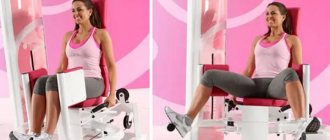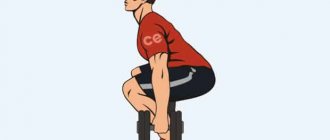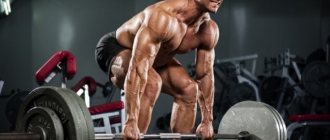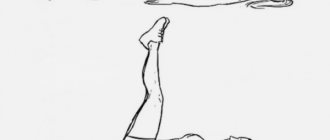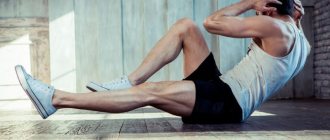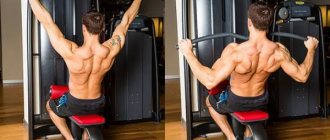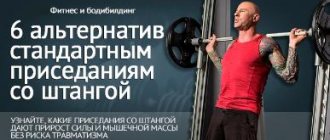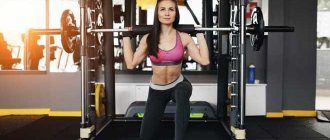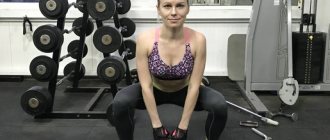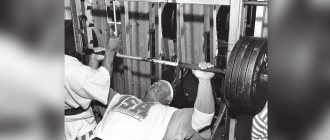Squats are a category of basic exercises that are one of the most effective for working the muscles of the hips and buttocks, as well as involving the muscles of the back, abs and arms. There are many variations of squats, one of the popular ones is the Smith machine squat. We will talk about them in detail.
- Smith machine pros and cons
- What muscles work when squatting on a Smith machine?
- Benefits of Smith Squats
- Technique for performing squats in the Smith machine, how to squat correctly with a barbell in Smith
- Smith Narrow Leg Squats
- Video: Smith squat technique with narrow leg stance
- With a wide stance
- Video: sumo squat technique in the Smith machine
- Squat with legs forward, which is impossible to do with free weight
- Video: Smith squat technique with legs moving forward
- Front Squats
- Video: Smith front squat technique
- Recommendations for performing squats in Smith
Smith machine pros and cons
The Smith machine can be found in almost every gym. Its popularity is due to its versatility and convenience for both beginner athletes and professionals.
Smith machine design.
This simulator is a structure consisting of a metal frame and a vertically moving barbell in it, which can be fixed at different heights using hooks. These hooks are placed in loops or thrown onto special stops located on the frame of the exercise machine.
Fixing the barbell in the Smith machine.
The Smith machine allows you to do more than just squats and lunges. In it you can do deadlifts, bench presses while standing or sitting (on the deltoids), bench presses if you place a bench under the machine, bending over with a barbell on your shoulders and many other exercises. That is, with the help of it you can pump up almost any muscle group, and such a simulator is a truly indispensable thing for any gym.
Useful tips
The Smith squat for girls should be performed only after the main warm-up of the body. To do this, it is enough to do several bends to straight legs, turns to the sides and a hitch of the arms and legs. If during training you experience discomfort in the area where the bar touches your body, you can place a pad or towel there. This method will also avoid possible bruising and tension on the delicate skin. When your knees hurt during squats, it is recommended to pay attention to the correct position of them. Discomfort in the joints can occur if they are facing in the wrong direction.
For example, when performing a squat correctly, your knees point in the same direction as your feet. If during training a girl does not feel enough load, then she needs to place her legs wider than the chosen option or move them beyond the line of the bar. And in the case when the pelvis “walks” when squatting and standing up, you need to try to perform the exercise outside of the “Smith”, and it is recommended to strain the body as much as possible and see why it is moving away from the point of fixation. To do this, you need to bend over, straighten up and bring your shoulder blades together as much as possible, and in this position try to sit down.
For beginners, when working in a fitness machine, it happens that the bar gets caught in the grooves for the safety fixation and there is not enough strength to return it to the working position. In this case, you need to approach the bar from the other side and twist it to release the bar.
What muscles work when squatting on a Smith machine?
Since squats in the Smith machine differ greatly in technique, the load can shift to certain muscles, but mainly it falls on:
- quadriceps (quadriceps muscles)
Anatomy of the muscles of the front of the thigh.
- large buttocks
- biceps femoris (biceps muscle)
- semimembranosus femoris muscle
- semitendinosus femoris muscle
Anatomy of the muscles of the buttocks and back of the thigh.
- vertebral extensors
Anatomy of the back muscles.
The abdominal and back muscles help maintain balance. In addition, we work with a barbell, so the upper back muscles (trapezius) and arms are included in the work.
Benefits of Smith Squats
The Smith machine has its pros and cons, let's look at its advantages. The Smith machine is a great option for a beginner because it makes it easy to master the exercise technique. With free weight or even without it, the body begins to “walk”: the legs shake and turn inward, the back rounds, the body leans forward, and so on. The Smith machine has the ability to fix the exerciser, which allows him to perform the exercise more correctly.
The load on the lower back and knees in Smith is reduced, which reduces the risk of injury, and also allows a beginner or a person recovering from an injury to exercise.
There is no need for an insurer. This is especially true for girls and women, since it is advisable to insure them even with a weight of 50 kg or more. In Smith, the exercise can be performed independently - the system of limiters will allow you not to drop the barbell or fall with it.
With the help of this simulator, it becomes possible to perform an exercise that human anatomy simply does not allow you to do in any other way. We are talking about a version of squats, when the feet are moved significantly forward. When squatting without support, you will fall, but the simulator holds you securely, allowing you to implement the exercise.
Common mistakes
Beginners should have an idea of the most common mistakes when performing this exercise so that they know what to look for first.
- One of the main mistakes is overestimating your strength and choosing the wrong barbell weights.
- Incorrect head position, looking at the floor or up.
- A shallow squat with a barbell that does not reach the end will be considered incorrect execution.
- The back is uneven.
- Bringing your knees together.
- Transferring weight to your toes.
Front squats are a good alternative to more popular exercises that reduce stress on your back and develop your quadriceps at home or in the gym. You can choose several options for performing different projectiles, depending on your level of training and your own desire. It is important to follow the correct technique to avoid injury. First of all, experienced athletes who are ready to diversify their training should pay attention to the front squat.
Technique for performing squats in the Smith machine, how to squat correctly with a barbell in Smith
As we have noticed, Smith squats can be performed in different ways. Let's look at the technique of the most popular variations of the exercise:
- with narrow legs
- with wide stance
- with feet forward
- frontal
Smith Narrow Leg Squats
To maintain balance during regular squats, it is recommended to stand with your feet approximately shoulder-width apart. When your legs are very narrow, it will be quite difficult to squat deeply. This problem is eliminated when we squat in a Smith machine - the bar reliably keeps us from falling.
The Smith machine allows you to comfortably squat with a narrow leg stance without the risk of losing your balance.
In this case, there are variations when the feet are brought forward - beyond the line of the simulator.
The most difficult version of this exercise is when the legs stand together or almost together far beyond the line of the machine.
In this case, the quadriceps muscles are loaded the most. You can engage your hamstrings by placing your feet further out and squatting lower.
Technique:
- We place the barbell on the upper back (top of the trapezius) and shoulders. Do not place the Smith machine bar on your neck under any circumstances, as this can cause injury.
- We remove the bar from the loops and take a step forward. To understand how much you need to step, focus on your height, leg length and feeling of comfort. It is unlikely that you will be able to take a comfortable stance the first time, so experiment.
- We place our feet together or almost together. The closer your feet are, the more difficult it is to squat and the greater the load on your quadriceps.
- The back in the Smith machine is well supported, so you won't be able to slouch, but still make sure to keep your back rigid.
- As you inhale, we begin to lower ourselves down, bending our knees.
- Squat until you can maintain balance and the weight of the machine. If you squat to parallel or slightly higher, the load goes entirely to the front muscles of the thigh. If you squat low (below parallel), your glutes and hamstrings will be activated.
- Exhale as we rise up and repeat the exercise.
It is best to squat with a narrow leg position for 6–10 reps, 4 working approaches.
Video: Smith squat technique with narrow leg stance
Video of exercise technique: squats in a Smith machine with narrow legs
With a wide stance
A more comfortable and easier version of Smith squats is with a wide stance. In this case, depending on the width of the legs, certain muscles will be loaded to a greater extent.
- With an average position of the legs (approximately shoulder-width apart), as in the previous version, the front surface of the thigh works most strongly.
If you squat in a Smith machine with a medium foot position, the quadriceps are more loaded.
- When the legs are set wide (wider than the shoulders), the gluteal muscles are loaded a little more.
If you want to work the entire thigh, it is better to choose a neutral foot position - neither narrow nor wide.
- And if the position of the legs is almost the same as in sumo or plie squats, we can work the muscles of the inner thigh.
The wider the position of the legs, the more the muscles of the inner thigh are involved.
Exercise technique:
- Place the bar on your upper back, remove the machine from its hinges and take half a step forward.
- We place our legs at a comfortable width and depending on the muscles being targeted. We turn our socks to the sides.
- Inhale, move your pelvis back and begin to bend your knees.
- We squat to parallel with the floor or slightly lower.
- We linger at the bottom point for 2-3 seconds and exhale as we rise to the top.
We repeat the exercise 8–12 times, 3–4 approaches.
Video: sumo squat technique in the Smith machine
Squat with legs forward, which is impossible to do with free weight
This option is an unnatural way to squat, so it won’t be possible to repeat it without support. In a similar way, you can squat in a Smith machine, in a Hack machine, or with your back against a wall. The peculiarity of the exercise is that you can achieve two right angles at once: between the back and the thigh; between the thigh and shin.
Squats with legs forward are a unique exercise that cannot be performed without support.
Exercise technique:
- We stand under the barbell, placing it on the upper part of the trapezius muscles and shoulders.
- We take the bar off the loops and take a big step forward.
- When we start to go down, we rest our backs against the barbell (it will support you).
- There is no need to abduct the pelvis.
- Lower yourself to the depth at which you can still hold yourself and the projectile, and exhale as you rise up.
Since this is an exercise for building muscle mass, we repeat it 8-12 times for 3-4 approaches.
Video: Smith squat technique with legs moving forward
Front Squats
This exercise is a rather complex type of squats. In this version, we fix the barbell not on the shoulders, but hold it in front - on the upper chest. This way you can reduce the load on your back, and the Smith machine makes it even more convenient to keep your balance.
With a front squat, it is easier to target the quadriceps.
Exercise technique
- The barbell must be placed so that it is on the front deltoids, collarbones and upper pectoral muscles.
- Place your hands on the barbell, having previously crossed them, and press the machine towards you.
Correct hand position for a front squat.
- We place our feet shoulder-width apart or slightly wider.
- As you inhale, we begin to lower ourselves down, bending our knees and moving our pelvis back.
- Squat until parallel to the floor or slightly lower.
- Pause at the bottom and return to the starting position, exhaling at the moment of greatest stress.
Repeat 6–8 times for 3–4 working approaches.
Video: Smith front squat technique
Specifics and contraindications
Kneeling squats with weights are specific exercises that should be used to comprehensively work the muscles of the legs and buttocks. They are not used to build muscle mass. Other functional exercises, such as lunges, are better suited for these purposes.
Kneeling squats have some contraindications. They should not be performed in case of spinal or knee injuries. Also, the exercise is not suitable for beginners. To increase the comfort of movement, you can use soft knee pads.
Recommendations for performing squats in Smith
Smith machine squats are a great exercise. It seems very difficult for beginners, but you shouldn’t neglect it, it’s a fairly safe way to learn how to squat with weight. However, it is worth following certain recommendations:
- Always keep your body weight on your heels.
- Do not place the barbell on the bottom of your neck, even if the weight is light.
- When doing front squats, you don't have to cross your arms if you have flexible hands.
- If you've had a history of lower back or knee injuries, it's best to practice your technique at Smith and don't move on to heavy free weights until you feel comfortable.
- Many people think that they will lose their balance if they start squatting in a Smith machine with their legs moving forward. This will not happen if you do not take too much weight, and during the squat you begin to press your shoulders into the bar, as if pushing it back.
- Make sure that your knees do not go beyond your toes, otherwise they will be overloaded.
- The Smith machine “does not like” speed exercises. Everything needs to be done slowly and smoothly.
- If you have a weak back, it is better to use a special safety belt.
Smith machine squats help the trainee gain confidence by safely performing difficult compound exercises and practice technique without risking damage to the back and knees. If something doesn't work out for you, or you're not sure you're doing an exercise correctly, try working on it in Smith. As a result, you will be able to work and strengthen your muscles, as well as master the correct technique. However, do not consider this exercise as a replacement for free weight squats. Research shows that with regular training, the effectiveness of Smith squats in increasing strength and muscle growth will be lower.
Contraindications for use
Like all basic strength-oriented leg exercises, Smith squats have a number of contraindications:
- Serious diseases and injuries of the spine
The compression load on the spine in Smith is much less, which allows people with minor back problems to squat safely in it.
But if you experience unpleasant pain or discomfort in your back while doing this exercise, it is better to abandon it.
- Diseases and injuries of the knees and hip joints, as well as muscles involved in movement
- Heart problems and a tendency to high blood pressure
